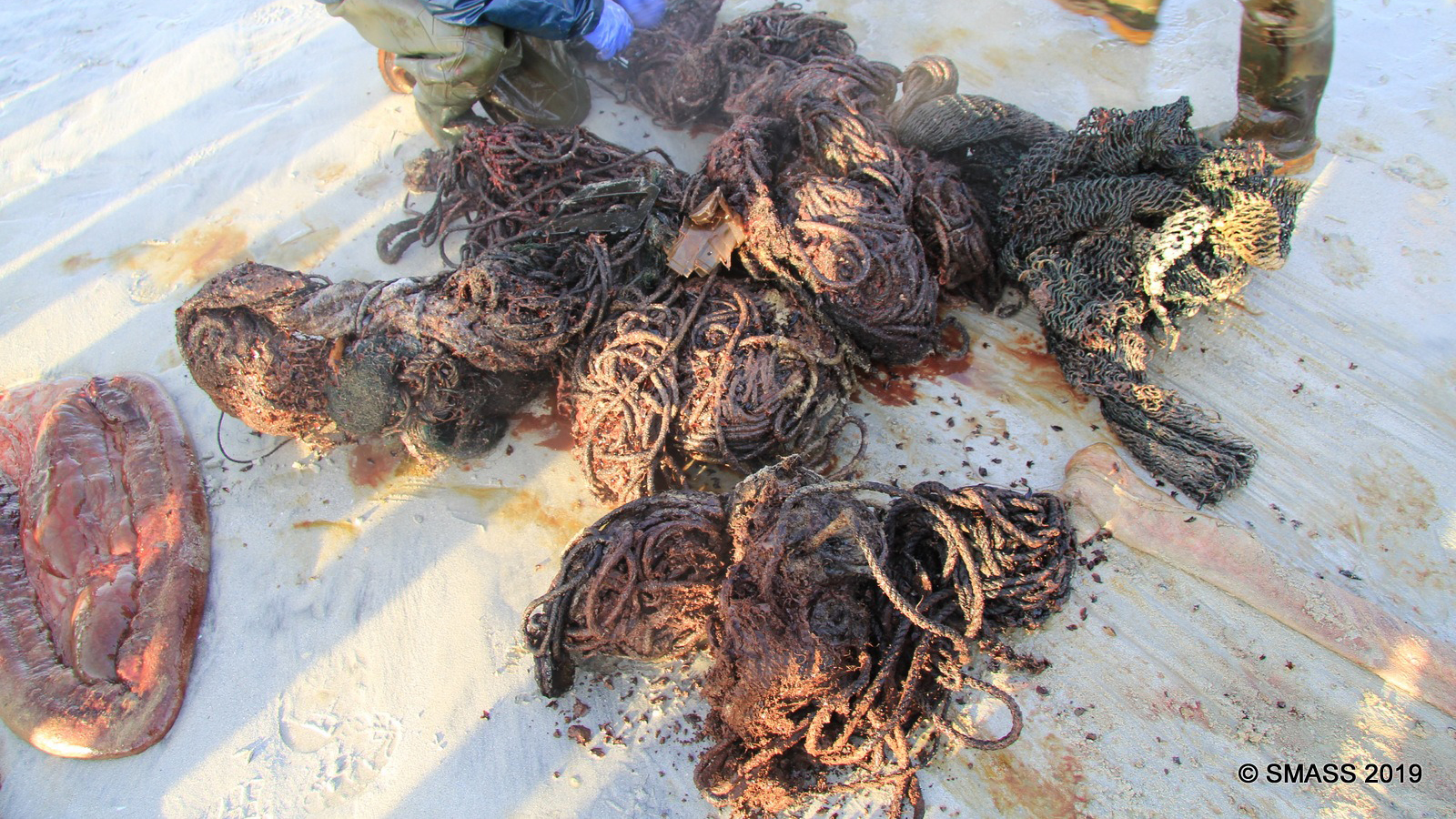220-lb. 'Litter Ball' Found Inside a Dead Sperm Whale's Belly
Tangled ropes, fishing nets and assorted plastic debris filled its stomach.

When workers with a whale strandings agency in Scotland performed a necropsy on a recently beached sperm whale, they found a gruesome surprise: The animal had died with around 220 lbs. (100 kilograms) of trash in its stomach.
The young male sperm whale (Physeter macrocephalus) washed ashore on Nov. 28 at Luskentyre beach in Scotland's Outer Hebrides islands. It died shortly thereafter, a representative with the Scottish Marine Animal Strandings Scheme (SMASS), part of the Cetacean Strandings Investigation Programme at Scotland's Rural College (SRUC) in Aberdeen, wrote on Facebook on Dec. 1.
Fishing nets, rope bundles, tubes and an assortment of plastic garbage formed a compact mass — a so-called litter ball — inside the 20-ton whale, "and some of it it looked like it had been there for some time," according to the post.
Related: Whale Photos: Giants of the Deep
Because whales' skin and blubber insulate them so effectively, bacteria inside a whale corpse can multiply quickly even when air temperatures are low. As the bacteria help to decompose the remains, they produce gases that then build up pressure inside the body, and the sperm whale on the Scottish beach was no exception — it "sort of exploded" upon investigation, according to the Facebook post.
"By the time we got to it, [it] had been dead for 48 hours and pretty much most of the guts blew out of the side when we stuck a knife in it," an SMASS representative wrote.
SMASS researchers and volunteers collect and analyze data on stranded animals that wash up along the Scottish coast, which includes 790 islands and spans nearly 12,000 miles (19,000 kilometers), according to the SMASS website. By performing necropsies and studying the remains of beached marine life — sharks, porpoises, dolphins, sea turtles and seals, as well as whales — scientists can better understand the biological and environmental conditions that lead to strandings.
Sign up for the Live Science daily newsletter now
Get the world’s most fascinating discoveries delivered straight to your inbox.
While the amount of garbage inside the whale was "horrific," the animal appeared to be in good health and wasn't malnourished, according to the post. It's likely that the trash ball interfered with digestion, but SMASS experts didn't find any signs that the ingested debris blocked the whale's intestines.

Garbage in
Other grim examples of dead whales with bellies full of plastic have washed up on other countries' shores. A pregnant sperm whale that floated up to an Italian beach in April died with 49 lbs. (22 kg) of trash in her stomach, and a Cuvier's beaked whale that beached in the Philippines in March had swallowed 88 lbs. (40 kg) of trash. Sperm whales that beached in 2018 in Spain and Indonesia carried similarly indigestible masses in their guts, Live Science previously reported.
In the United Kingdom, stranded marine animals commonly have microplastic particles in their bodies, though it's unknown how this affects their overall health, researchers reported in January in the journal Nature. But beached animals with quantities of large debris in their bellies are rare in the coastal U.K., SMASS Stranding Coordinator Nick Davison told Live Science.
In the recent stranding, the assortment of trash in the sperm whale's gut underscores the global issue of widespread marine pollution caused by a range of human activities — on land and in the seas, according to the Facebook post.
"This whale had debris in its stomach which seemed to have originated from both the land and fishing sectors, and could have been swallowed at any point between Norway and the Azores," SMASS representatives wrote on Facebook. "We are looking in more detail to see if we can work out quite why this animal ended up with so much of it in its stomach."
- In Photos: World's Most Polluted Places
- Images: Sharks & Whales from Above
- The World's Biggest Beasts: Here and Gone
Originally published on Live Science.

Mindy Weisberger is an editor at Scholastic and a former Live Science channel editor and senior writer. She has reported on general science, covering climate change, paleontology, biology and space. Mindy studied film at Columbia University; prior to Live Science she produced, wrote and directed media for the American Museum of Natural History in New York City. Her videos about dinosaurs, astrophysics, biodiversity and evolution appear in museums and science centers worldwide, earning awards such as the CINE Golden Eagle and the Communicator Award of Excellence. Her writing has also appeared in Scientific American, The Washington Post and How It Works Magazine. Her book "Rise of the Zombie Bugs: The Surprising Science of Parasitic Mind Control" will be published in spring 2025 by Johns Hopkins University Press.










